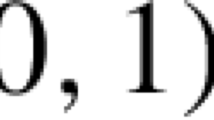Abstract
Kinetic-transport equations are, by now, standard models to describe the dynamics of populations of bacteria moving by run-and-tumble. Experimental observations show that bacteria increase their run duration when encountering an increasing gradient of chemotactic molecules. This led to a first class of models which heuristically include tumbling frequencies depending on the path-wise gradient of chemotactic signal. More recently, the biochemical pathways regulating the flagellar motors were uncovered. This knowledge gave rise to a second class of kinetic-transport equations, that takes into account an intra-cellular molecular content and which relates the tumbling frequency to this information. It turns out that the tumbling frequency depends on the chemotactic signal, and not on its gradient. For these two classes of models, macroscopic equations of Keller-Segel type, have been derived using diffusion or hyperbolic rescaling. We complete this program by showing how the first class of equations can be derived from the second class with molecular content after appropriate rescaling. The main difficulty is to explain why the path-wise gradient of chemotactic signal can arise in this asymptotic process. Randomness of receptor methylation events can be included, and our approach can be used to compute the tumbling frequency in presence of such a noise.



Similar content being viewed by others
References
Berthelin F, Mauser NJ, Poupaud F (2007) high-field limit from a kinetic equation to multidimensional scalar conservation laws. J Hyp Diff Eq 4(1):123–145
Bournaveas N, Calvez V (2009) Critical mass phenomenon for a chemotaxis kinetic model with spherically symmetric initial data. Ann Inst H Poincaré Anal Non Linéaire 26(5):1871–1895
Bournaveas N, Calvez V (2008) Global existence for the kinetic chemotaxis model without pointwise memory effects, and including internal variables. Kinet Relat Models 1(1):29–48
Bournaveas N, Calvez V, Gutièrrez S, Perthame B (2008) Global existence for a kinetic model of chemotaxis via dispersion and Strichartz estimates. Comm PDE 33:79–95
Chalub F, Markowich PA, Perthame B, Schmeiser C (2004) Kinetic models for chemotaxis and their drift-diffusion limits. Monatsh Math 142:123–141
Dolak Y, Schmeiser C (2005) Kinetic models for chemotaxis: Hydrodynamic limits and spatio-temporal mechanisms. J Math Biol 51:595–615
Endres RG (2013) Physical principles in sensing and signaling, with an introduction to modeling in biology. Oxford University Press, Oxford
Erban R, Othmer H (2004) From individual to collective behaviour in bacterial chemotaxis. SIAM J Appl Math 65(2):361–391
Erban R, Othmer H (2007) Taxis equations for amoeboid cells. J Math Biol 54:847–885
Hazelbauer GL (2012) Bacterial chemotaxis: the early years of molecular studies. Annu Rev Microbiol 66:285–303
Hillen T, Painter K (2012) Transport and anisotropic diffusion models for movement in oriented habitats. In: Lewis MA, Maini P, Petrowskii S (eds) Dispersal, individual movement and spatial ecology: a mathematical perspective. Springer, Heidelberg, pp 177–222
Hwang HJ, Kang K, Stevens A (2005) Global solutions of nonlinear transport equations for chemosensitive movement. SIAM J Math Anal 36:1177–1199
James F, Vauchelet N (2013) Chemotaxis : from kinetic equations to aggregate dynamics. Nonlinear Diff Eq Appl 20(1):101–127
Jiang L, Ouyang Q, Tu Y (2010) Quantitative modeling of Escherichia coli chemotactic motion in environments varying in space and time. PLoS Comput Biol 6:e1000735
Kalinin YV, Jiang L, Tu Y, Wu M (2009) Logarithmic sensing in Escherichia coli bacterial chemotaxis. Biophys J 96(6):2439–2448
Locsei JT (2007) Persistence of direction increases the drift velocity of run and tumble chemotaxis. J Math Biol 55(1):41–60
Liao J (2016) Global solution for a kinetic chemotaxis model with internal dynamics and its fast adaptation limit. J Diff Equ 259(11):6432–6458
Othmer H, Dunbar S, Alt W (1988) Models of dispersal in biological systems. J Math Biol 26:263–298
Othmer HG, Hillen T (2002) The diffusion limit of transport equations II: chemotaxis equations. SIAM J Appl Math 62:122–1250
Othmer HG, Xin X, Xue C (2013) Excitation and adaptation in bacteria-a model signal transduction system that controls taxis and spatial pattern formation. Int J Mol Sci 14(5):9205–9248
Porter SL, Wadhams GH, Armitage JP (2008) Rhodobacter sphaeroides: complexity in chemotactic signalling. Trends Microbiol 16(6):251–260
Rao CV, Kirby JR, Arkin AP (2004) Design and diversity in bacterial chemotaxis: a comparative study in Escherichia coli and Bacillus subtilis. PLoS Biol 2(2):E49
Saragosti J, Calvez V, Bournaveas N, Buguin A, Silberzan P, Perthame B (2010) Mathematical description of bacterial traveling pulses. PLoS Comput Biol 6(8):e1000890. doi:10.1371/journal.pcbi.1000890
Saragosti J, Calvez V, Bournaveas N, Perthame B, Buguin A, Silberzan P (2011) Directional persistence of chemotactic bacteria in a traveling concentration wave. Proc Natl Acad Sci 108(39):16235-16240
Si G, Tang M, Yang X (2014) A pathway-based mean-field model for E. coli chemo- taxis: mathematical derivation and keller-segel limit. Multiscale Model Simul 12(2):907–926
Si G, Wu T, Ouyang Q, Tu Y (2012) A pathway-based mean-field model for Escherichia coli chemotaxis. Phys Rev Lett 109:048101
Tu Y, Shimizu TS, Berg HC (2008) Modeling the chemotactic response of Escherichia coli to time-varying stimuli. Proc Natl Acad Sci USA 105(39):14855–14860
Vauchelet N (2010) Numerical simulation of a kinetic model for chemotaxis. Kin Rel Models 3(3):501–528
Xin X, Othmer HG (2012) A trimer of dimers-based model for the chemotactic signal transduction network in bacterial chemotaxis. Bull Math Biol 74(10):2339–2382
Xue C, Othmer HG (2009) Multiscale models of taxis-driven patterning in bacterial populations. SIAM J Appl Math 70(1):133–167
Xue C (2015) Macroscopic equations for bacterial chemotaxis: integration of detailed biochemistry of cell signaling. J Math Biol 70:1–44
Zhu X, Si G, Deng N, Ouyang Q, Wu T, He Z, Jiang L, Luo C, Tu Y (2012) Frequency-dependent Escherichia coli chemotaxis behavior. Phys Rev Lett 108:128101
Acknowledgments
Benoît Perthame and Nicolas Vauchelet are partially supported by ANR Kibord-ANR-13-BS01-0004 funded by the French Ministry of Research. Min Tang is partially supported by NSF of Shanghai under Grant 12ZR1445400, NSFC 11301336 and 91330203, and Shanghai Pujiang Program 13PJ140700.
Author information
Authors and Affiliations
Corresponding author
Rights and permissions
About this article
Cite this article
Perthame, B., Tang, M. & Vauchelet, N. Derivation of the bacterial run-and-tumble kinetic equation from a model with biochemical pathway. J. Math. Biol. 73, 1161–1178 (2016). https://doi.org/10.1007/s00285-016-0985-5
Received:
Revised:
Published:
Issue Date:
DOI: https://doi.org/10.1007/s00285-016-0985-5




